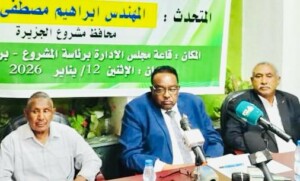Sudan OCHA bulletin 12: Influx from South Sudan refugees in western Sudan
Heightened food insecurity and violence in parts of South Sudan have resulted in a new influx of people from Northern Bahr El Ghazal and Warrap states in East and South Darfur, and West Kordofan. About 34,000 have arrived since late January, the UN Office for the Coordination of humanitarian Affairs (OCHA) in Sudan states in its latest weekly bulletin.
Heightened food insecurity and violence in parts of South Sudan have resulted in a new influx of people from Northern Bahr El Ghazal and Warrap states in East and South Darfur, and West Kordofan.
About 34,000 have arrived since late January, the UN Office for the Coordination of humanitarian Affairs (OCHA) in Sudan states in its latest weekly bulletin.
In East Darfur, the monitoring and registration committee -consisting of the Sudanese Red Crescent Society (SRCS), the government’s Humanitarian Aid Commission (HAC), and the Sudanese Mercy Organization and El Mubadiroun- reported the arrival of an estimated 27,200 South Sudanese since the end of January. The majority (21,237 people) have settled in Khor Omer camp.
OCHA and UNHCR are jointly coordinating the response for these new arrivals. The World Food Programme (WFP) -through the SRCS- has distributed one-month emergency food rations to 16,240 people in Khor Omer. Distributions are ongoing for the remaining arrivals.
In the Bielel camp for the displaced in South Darfur, the office of the Commissioner for Refugees (COR) and HAC have registered over 2,000 new arrivals. They have access to existing water, sanitation and health facilities, but need hygiene and essential household items.
In its 17 March update, UNHCR said that HAC reported the arrival of 4,848 South Sudanese in West Kordofan in February. The new arrivals reportedly need food, water, emergency household supplies and protection assistance. WFP is making the necessary arrangements to start assisting the new South Sudanese refugees in El Meiram. It also plans to conduct a verification and food distribution for 7,700 South Sudanese old and new arrivals in Kharasana over the coming days.
According UNHCR, by 14 March 197,704 South Sudanese had arrived in Sudan since mid-December 2013 when fighting erupted in South Sudan. Of these people, about 130,000 have received some form of humanitarian assistance.

Response to Jebel Marra displaced continues
As of 20 March, an estimated 129,200 internally displaced persons (IDP) have reportedly taken refuge in North, Central, and South Darfur, according to aid agencies and government authorities.
The WFP that provided food to the more than 60,000 displaced who have taken refuge in Sortony in Kabkabiya locality in North Darfur, will do a headcount exercise next week to get a better picture of the number of the people sheltering near the Unamid team site in Sortony.
The water supply improved but declined again on 17 March because of the reported refusal of water truck owners to travel to Kabkabiya without an escort. Oxfam-America has built 200 out of the 1,000 latrines planned. This brings the total number of latrines available in the area to 700.
In addition to the three clinics already in the area, the national NGO El Massar is currently building a new clinic. It will be supported by the World Health Organization (WHO) and the North darfur Health Ministry. Médecins Sans Frontières-Spain (MSF-E) reports that their clinic receives an average of 200 consultations per day.
In Kabkabiya town, 2,018 new displaced were verified by WFP through emergency food distributions.
In Tawila, the UN Population Fund (UNFPA) sent 500 clean delivery kits to the two clinics in the area. One clinic is run by MSF-E and the other is run by the Sudanese SAKER Voluntary Organisation. MSF-E has reported 26 whooping cough cases among the new displaced. WHO has suggested conducting a Penta 3 vaccination campaign (diphtheria-tetanus-pertussis, hepatitis B, and inactivated polio) to order to contain the disease.
In Shangil Tobaya’s Shadad camp, an estimated 4,495 people from Jebel Marra have taken refuge with verification ongoing. The Sudanese Dar El Salam Development Association (DDA) distributed some essential household and hygiene supplies and built 10 out of the 50 latrines planned. WFP registered and verified 2,000 displaced in Shangil Tobaya through the distribution of emergency food.
In Central Darfur, authorities assist newly displaced from Jebel Marra
According to HAC in Central Darfur, 5,940 displaced were registered in Nierteti, 1,735 in Tur, and 4,325 in Guldo. 1,009 people fled to in Hasahisa camp and 240 to Hamidiya camp in Zalingei town.
According to the state authorities, the new arrivals are living either with the host community or with family members and have no need for shelter assistance at this time. Nevertheless, authorities have 1,500 plastic sheets and 200 tents in stock, which will be distributed as needed.
Authorities have requested Unicef to support WES in repairing existing water sources and following up on finding new water sources. Aid organisations continue to advocate for access to all the new displaced from Jebel Marra in the state.
WFP continues to provide aid to South Sudan from Sudan
WFP continues to prioritise the provision of emergency food assistance through the humanitarian corridor from Sudan to South Sudan considering the lack of land access to affected populations through western corridors.
Since the opening of the corridor in 2014, WFP Sudan has successfully transported 30,373 metric tons (MT) of emergency food and nutrition assistance for 203,000 conflict-affected people, with the consistent facilitation of the Joint Technical Committee (JTC). From 16-17 March, members of the Committee visited White Nile State to monitor the Kosti logistics operations and assure road conditions remain suitable for operational use in order to maintain the corridors efficiency and the momentum to provide urgently needed support to vulnerable communities.
Over 115,000 returnees in West Darfur in 2015
The International Organization for Migration (IOM) has registered 115,653 returnees in West Darfur last year. 98 percent of the returnees were permanent, with the rest being seasonal.
IOM said that 57 percent of returnees (close to 66,000 people) arrived from outside of Sudan, mainly from Chad, 42.5 percent returned from locations within West Darfur, and 0.5 percent came from South and Central Darfur.
West Darfur accounts for almost 80 percent of the total of 146,626 returnees registered across Darfur by IOM in 2015.
Read the full bulletin here











 and then
and then